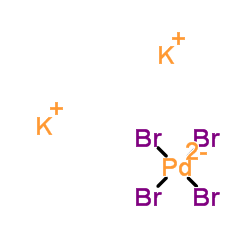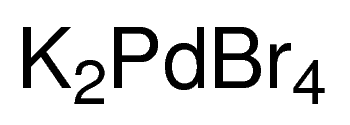四溴钯酸钾, Pd ≥20.5%,Potassium tetrabromopalladate
产品编号:西域试剂-WR363177| CAS NO:13826-93-2| MDL NO:MFCD00049659| 分子式:K2PdBr4| 分子量:504.2
本网站销售的所有产品仅用于工业应用或者科学研究等非医疗目的,不可用于人类或动物的临床诊断或者治疗,非药用,非食用,
| 产品名称 | 四溴钯酸钾, Pd ≥20.5% |
|---|---|
| 英文名称 | Potassium tetrabromopalladate |
| CAS编号 | 13826-93-2 |
| 精确质量 | 499.504211 |
| LogP | 3.38240 |
| 稳定性 | 常温常压下稳定 避免的物料 水分/潮湿 还原剂 |
| 储存条件 | 常温密闭,阴凉通风干燥 |
相关文档
化学品安全说明书(MSDS)
下载MSDS质检证书(COA)
相关产品
| 符号 |

GHS07 |
|---|---|
| 信号词 | Warning |
| 危害声明 | H315-H319-H335 |
| 警示性声明 | P261-P305 + P351 + P338 |
| 个人防护装备 | dust mask type N95 (US);Eyeshields;Gloves |
| 危害码 (欧洲) | Xi |
| 风险声明 (欧洲) | R36/37/38 |
| 安全声明 (欧洲) | S26-S36 |
| 危险品运输编码 | NONH for all modes of transport |
| WGK德国 | 3 |
|
Section 1: Product Identification Chemical Name:Potassium tetrabromopalladate(II), 98% CAS Registry Number:13826-93-2 Formula:K2PdBr4 EINECS Number:237-535-6 Chemical Family:halometallate salt Synonym:Dipotassium palladium tetrabromide
Section 2: Composition and Information on Ingredients IngredientCAS NumberPercentACGIH (TWA)OSHA (PEL) Title Compound13826-93-2100%no datano data Section 3: Hazards Identification Irritating to skin, eyes and the respiratory tract. Bromide exposure may cause central nervous system effects Emergency Overview: and skin rashes. Primary Routes of Exposure:Contact with skin and eyes. Inhalation of dust. Eye Contact:Causes mild irritation to the eyes. Skin Contact:Causes slight irritation of the skin. Inhalation:Dust causes irritation to the respiratory tract; symptoms may include coughing and shortness of breath. Ingestion:May cause nausea, vomiting and abdominal pain and produce central nervous system effects. Irritating to skin, eyes and respiratory tract. Symptoms of bromide ingestion may include skin rash, blurred Acute Health Affects: vision, drowsiness, irritability, dizziness, mania, hallucinations, and coma. Repeated or prolonged exposure to bromides by any route may cause skin rashes (bromaderma) and central Chronic Health Affects: nervous system depression, including ataxia, psychoses, memory loss, irritability, and headache. NTP:No IARC:No OSHA:No SECTION 4: First Aid Measures Immediately flush the eyes with copious amounts of water for at least 10-15 minutes. A victim may need Eye Exposure: assistance in keeping their eye lids open. Get immediate medical attention. Wash the affected area with water. Remove contaminated clothes if necessary. Seek medical assistance if Skin Exposure: irritation persists. Remove the victim to fresh air. Closely monitor the victim for signs of respiratory problems, such as difficulty Inhalation: in breathing, coughing, wheezing, or pain. In such cases seek immediate medical assistance. Seek medical attention immediately. Keep the victim calm. Give the victim water (only if conscious). Induce Ingestion: vomiting only if directed by medical personnel. SECTION 5: Fire Fighting Measures Flash Point:not applicable Autoignition Temperature:none Explosion Limits:none Extinguishing Medium:None. Material is non-flammable. Special Fire Fighting Procedures:No special fire fighting procedures required. Hazardous Combustion andnone Decomposion Products: Unusual Fire or Explosion Hazards: No unusual fire or explosion hazards. SECTION 6: Accidental Release Measures To avoid raising dust, small spills may be mixed with diatomaceous earth, sand, vermiculite or other suitable Spill and Leak Procedures: inert material and swept up. SECTION 7: Handling and Storage Store solid in a tightly sealed container away from moisture. Handle under a dry atmosphere of air or nitrogen. Handling and Storage: Prolonged exposure to the atmosphere may degrade the product. SECTION 8: Exposure Controls and Personal Protection Eye Protection:Always wear approved safety glasses when handling a chemical substance in the laboratory. Skin Protection:Wear protective clothing and gloves. Consult with glove manufacturer to determine the proper type of glove. Ventilation:Material may form a fine dust. If possible, handle the material in an efficient fume hood. If in form of fine dust and ventilation is not available a respirator should be worn. The use of respirators Respirator: requires a Respirator Protection Program to be in compliance with 29 CFR 1910.134. Ventilation:Material may form a fine dust. If possible, handle the material in an efficient fume hood. Additional Protection:No additional protection required. SECTION 9: Physical and Chemical Properties Color and Form:reddish-brown pwdr. Molecular Weight:504.21 Melting Point:no data Boiling Point:no data Vapor Pressure:not applicable Specific Gravity:no data Odor:none Solubility in Water:very soluble SECTION 10: Stability and Reactivity Stability:hygroscopic Hazardous Polymerization:no hazardous polymerization Conditions to Avoid:contact with moisture Incompatibility:Active metals Decomposition Products:potassium bromide, palladium bromide, palladium, and bromine. SECTION 11: Toxicological Information RTECS Data:No information available in the RTECS files. Carcinogenic Effects:no data Mutagenic Effects:no data Tetratogenic Effects:no data SECTION 12: Ecological Information Ecological Information:No information available SECTION 13: Disposal Considerations Disposal:Dispose of according to local, state and federal regulations. SECTION 14: Transportation Shipping Name (CFR):Non-hazardous Hazard Class (CFR):NA Additional Hazard Class (CFR):NA Packaging Group (CFR):NA UN ID Number (CFR):NA Shipping Name (IATA):Non-hazardous Hazard Class (IATA):NA Additional Hazard Class (IATA):NA Packaging Group (IATA):NA UN ID Number (IATA):NA SECTION 15: Regulatory Information TSCA:Listed in the TSCA inventory. SARA (Title 313):Title compound not listed. Second Ingredient:none SECTION 16 - ADDITIONAL INFORMATION N/A |









 浙公网安备 33010802013016号
浙公网安备 33010802013016号